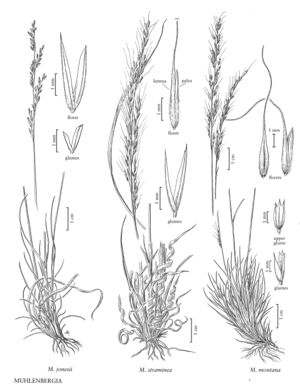Muhlenbergia montana
Plants perennial; cespitose, not rhizomatous. Culms 10-80 cm, erect, rounded near the base; internodes glabrous. Sheaths smooth or scabridulous, becoming flattened, papery, and occasionally spirally coiled when old, lower sheaths longer than the internodes; ligules 4-14 (20) mm, membranous, acute to acuminate; blades 6-25 cm long, 1-2.5 mm wide, flat, becoming involute, scabrous abaxially, hirsute adaxially. Panicles 4-25 cm long, (1) 2-6 cm wide, not dense; primary branches 0.5-10 cm, appressed or diverging up to 40° from the rachises; pedicels 0.5-6.5 mm, scabrous. Spikelets 3-7 mm. Glumes subequal, (1) 1.5-3.2 (4) mm, smooth or scabridulous distally; lower glumes 1-veined, sometimes with a less than 1 mm awn; upper glumes 1/3–2/3 as long as the lemmas, 3-veined, truncate to acute, 3-toothed, teeth sometimes awned, awns to 1.6 mm; lemmas 3-4.5 (7) mm, lanceolate, loosely to densely appressed-pubescent on the lower portion of the midveins and margins, hairs to 0.8 mm, apices acute to acuminate, awned, awns (2) 6-25 mm, flexuous; paleas 3-4.5 (7) mm, lanceolate, acute to acuminate; anthers 1.5-2.3 mm, purplish. Caryopses 1.8-2 mm, fusiform, light-brown. 2n = 20, 40.
Distribution
Colo., N.Mex., Tex., Utah, Calif., Mont., Ariz., Wyo.
Discussion
Muhlenbergia montana grows on rocky slopes and ridge tops and in dry meadows and open grasslands, at elevations of 1400-3500 m. Its range extends from the western United States to Guatemala. Muhlenbergia montana is sometimes difficult to distinguish from M. filiculmis, but that species has shorter spikelets and lemma awns and tightly involute or filiform, sharp blades.
Selected References
None.
Lower Taxa
"decumbent" is not a number.
